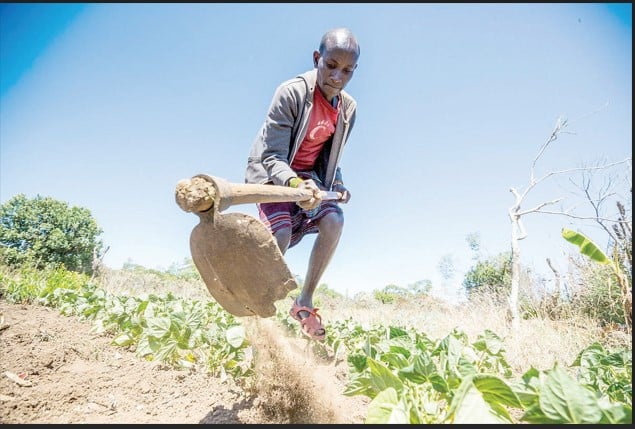Food and farming systems fight to survive in a hot, dry world

Scientists and agricultural experts have established that drought has affected more people around the globe than any other natural disaster.
The United Nations Food and Agriculture Organisation (FAO) has confirmed that drought, which occurs in nearly all regions, has affected more people worldwide in the last 40 years than any other natural hazard.
Drought is a complex natural phenomenon with varying levels of intensity, duration, spatial extent and impacts. Severe drought episodes have drastic socio-economic and environmental impacts, including, for example, massive famines and migration, natural resource degradation, and weak economic performance.
Agriculture is often the first to be affected when drought hits and also the most impacted sector, absorbing up to 80 per cent of all direct impacts, with multiple effects on agricultural production, food security and rural livelihoods, FAO’s latest statistics reveal.
Now with the past 10 years scientifically registered as the hottest 10 years on record, with higher temperatures and drier conditions making more regions vulnerable to drought and arid land degradation, or desertification.
This process is “a silent, invisible crisis that is destabilising communities on a global scale,” warns the UN Office for Disaster Risk Reduction.
The World Meteorological Organisation (WMO) says 2024 was the warmest year on record, based on six international datasets, marking “an extraordinary streak of record-breaking temperatures” annually over the past 10 years. Each year in the last decade is one of the ten warmest on record, WMO added.
New thinking
UN Secretary-General Antonio Guterres has described global heating as a cold, hard fact, insisting that the blazing temperatures in 2024 require trailblazing climate action in 2025. Guterres has called on governments to deliver new national climate action plans this year to limit long-term global temperature rise to 1.5 degrees Celsius (°C), and support the most vulnerable to deal with devastating climate impacts.
Life has become dangerous with 1.3 °C of human-induced warming, according to a recent report by the World Weather Attribution (WWA), which highlights the urgency of moving away from planet-heating fossil fuels as quickly as possible.
“Every broken record was not just a number, but accompanied by people losing their lives and livelihoods in ever hotter heatwaves and devastating floods,” notes WWA Co-lead Dr Friederike Otto.
Globally, the nearly 2 billion people who live in dryland areas are often the first to face hunger, thirst, and the devastating effects of poor soil and environmental decline, according to Dr ML Jat, the director of resilient farm and food systems at the International Crops Research Institute for the Semi-Arid Tropics (ICRISAT).
And the next generations will feel the effects, says Danielle Nierenberg, a world-renowned researcher on food systems and agriculture in the latest edition of the Food Tank Newsletter. UNICEF predicts that, by 2040, one in four children will live in areas of extremely high water stress, she notes.
“But there is a path toward a better future, there are farming and food system solutions that allow us to nourish communities in hotter, drier climates,” says Nierenberg, adding that indigenous crops, for example, are naturally adapted to the extreme weather in desert regions and can strengthen food security, community health and ecosystems.
“I’ve long admired the work of organisations like NATIVE Seeds/SEARCH, which conserve seeds so they can continue to benefit the peoples in the Southwest and Mexico and the Arizona Alliance for Climate-Smart Crops, which supports farmers in adopting climate smart crops and practices that conserve water”.
Dr Erin Riordan of the University of Arizona, told Food Tank that wild desert plants have a remarkable number of adaptations to cope with heat, drought, unpredictable rainfall, and poor soils—the sorts of stressful growing conditions we are already seeing and expect to see more in the future.
There are also innovative solutions that can be elevated to restore degraded landscapes and combat further desertification. The UN Convention to Combat Desertification (UNCCD), is supporting several amazing projects in Africa including the Great Green Wall (GGW) initiative, which works across 22 countries to revitalise fertile land and transform lives. More than US$14 billion has been raised to support this game-changing initiative.
The GGW initiative’s ambition is to restore 100 million hectares of currently degraded land, sequester 250 million tonnes of carbon and create 10 million green jobs by 2030, helping communities living along the Wall to grow.
The initiative will provide one of humanity’s most precious natural assets – fertile land, economic opportunities for the world’s youngest populations, food security for millions that go hungry every day, climate resilience in a region where temperatures are rising faster than anywhere else on Earth, and a new world wonder spanning 8,000 kilometres.
Microbial solutions
In Somalia, UNDP is partnering with local leaders to construct reservoirs and dams to improve water access and address deforestation and desertification.
“We can’t solve these challenges alone,” says Nierenberg.
A fascinating new ICRISAT report looks at the power of microbes to boost crop yields and restore soil health in dryland farming systems. These microbes could include bacteria that improve nitrogen-fixation, which can improve soil fertility and other microorganisms that and control diseases and crop pests.
“We need a whole-of-society approach to combating desertification—especially in parts of the world that have not traditionally struggled with arid landscapes and water scarcity, because, as we know, natural disasters like drought are affecting more and more people as the climate crisis deepens,” Nierenberg adds.
In an op-ed in Food Tank, author and agro-ecologist Gary Paul Nabhan argues that everyone across the entire food system must prioritise indigenous crops and adapt to changing environments.
“If farmers shift what crops they grow, they will need consumers, cooks, and chefs to adapt what they are willing to prepare and eat in the new normal,” Nabhan wrote.
It is time to turn the corner from corn and soy monocultures to the sesames, prickly pear cactus, garbanzos, millets and mulberries of the world that desert dwellers have eaten in delicious dishes for millennia.
Nierenberg asks how food agriculture system leaders and researchers in various communities across the globe are working to protect land from becoming degraded, noting that there are creative solutions that can help nourish neighbours and adapt food systems in hotter, drier climates.
Ecosystems are threatened all over the world. Forests, drylands, and farmlands are threatened, and the species that live there as well. Drought is the major disaster occurring in the African and Arab region, affecting millions of people.
The UNCCD says up to 40 per cent of the planet’s land is degraded, directly affecting half of the world’s population. The number and duration of droughts has increased by 29 per cent since 2000. Without urgent action, droughts may affect over three-quarters of the world’s population by 2050.
Humanity needs climate-smart solutions, recognising that we are living in drier and hotter times and producing food using less water. That means working with farmers to identify crops and varieties adapted to current and future climate conditions, selecting desert-adapted seeds and starts, and trial climate-smart practices.
These include alley cropping, using conservation cover, multi-storey cropping, agrivoltaics, reduced or no till agriculture, and supporting scaling and marketing to spread awareness of desert-adapted foods














